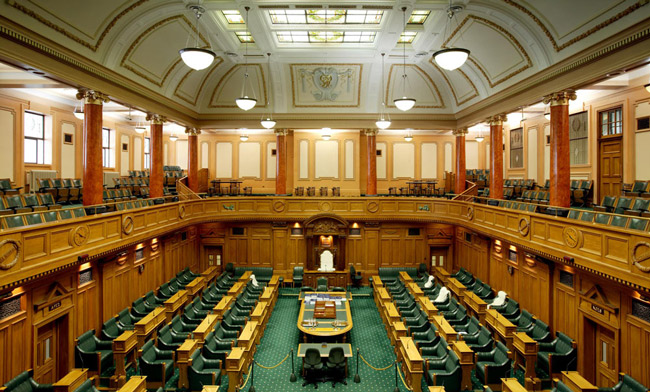This election campaign, like most others, has been rife with speculation about possible governing arrangements after 23 September. In this Opinion Piece written for the Otago Bulletin Board, the Head of Otago's Department of Politics and expert in MMP Janine Hayward offers her views.

The suspense grows... what will New Zealand Parliament look like after this weekend's election?

Professor Janine Hayward.
With fluctuating polls, a range of possibilities has been offered including a National-ACT-Māori party agreement, a National-New Zealand First agreement, a Labour-Greens-Māori Party agreement and even the National party governing on its own.
Throughout this speculation, New Zealand First has frequently been dubbed the 'King maker' (or 'deal maker' after Jacinda Ardern became Labour Party Leader). It is true that a centrist minor party like New Zealand First might play a significant role in the formation of government (as New Zealand First did in 1996). But speculation about 'the tail wagging the dog' risks overstating the influence of minor parties in determining governing arrangements and their role in determining policy once government is formed. If MMP history teaches us anything, it is that supporting government is a poisoned chalice for a minor party; the Alliance, Progressives, ACT, United Future, and New Zealand First have all seen their fortunes wax and mostly wane in support of governments.
One of the most far-fetched suggestions during this campaign was that Winston Peters might be offered half a term as Prime Minister to sweeten the deal. Despite being an attention-grabbing headline, any student of New Zealand politics will tell you that a Prime Minister who does not enjoy majority support in Cabinet is a fanciful and untenable suggestion.
So, what should we believe when it comes to the possible governing arrangements post-election?
Prior to 1996, New Zealand's first-past-the-post elections delivered governments. No-one talked about government formation as we do now; the party who won the most seats (always Labour or National) formed the government. Since 1996 however, MMP, has delivered parliaments not governments; in other words, we will know on election night who has been elected to Parliament (determined by the overall party vote) but we won't necessarily know who will form the next government. That is decided by the parties represented in Parliament. But how does this process of government formation happen?
"If MMP history teaches us anything, it is that supporting government is a poisoned chalice for a minor party."
Compared to other countries, New Zealand is notable for the absence of formal rules and structures around the process of government formation. The Governor-General is a key figure in this process but is not actively involved in determining the formation of government. Contrary to popular belief, the Governor-General does not 'invite' the leader of the largest party to try to form a government first. Rather, the Governor-General waits until one or more of the political parties declares that they have the support of a majority of elected MPs. This is called having 'the confidence of the House'. The Governor-General then formally swears in the new government. But, when a group of parties declares that it will form the next government, how does the Governor-General know that those parties will have 'the confidence of the House'. In other words, how does the Governor-General know a government when he or she sees one?
During his term as Governor-General, Sir Jerry Mataparae identified 'quantity and clarity' as useful guidelines for any Governor-General in making this important determination. Quantity refers to having the support of a majority of members of Parliament. We are used to that meaning that the parties that form government hold the majority of the seats. But this is not necessarily the case. It is possible for minority government to form if another party outside the governing arrangement states publicly and unambiguously that it will abstain on confidence votes (which test a government's majority) and vote on legislation case by case. This will mean that Governor-General can be confident that the opposition, even when they are the majority of MPs, will not vote the government down on important matters like the budget. While this arrangement can make a government's legislative agenda harder to carry out, it can produce stable minority government. We haven't had a government of this sort yet under MMP, but there is no reason it can't happen in future.
It is also possible that the parties which form the government do not include the party with the most MPs in Parliament. We have not yet had this situation either, but in terms of the principle of 'quantity' the largest party may not be able to secure a majority and hold the confidence of the House. In that case, silver and bronze might beat gold.
In terms of looking for 'clarity', the Governor-General requires clear, public statements by the parties about what sort of government has been formed, and unambiguous statements about where their allegiances lie in terms of supporting the government, or being in opposition.
"In terms of looking for 'clarity', the Governor-General requires clear, public statements by the parties about what sort of government has been formed, and unambiguous statements about where their allegiances lie in terms of supporting the government, or being in opposition."
The governing agreements between parties are usually formal and written down, which provides further clarity, but their content has varied considerably since 1996. A coalition government is the most substantial joining of parties to form a government and usually includes members from all parties holding ministerial positions. Labour and the Progressives had this sort of coalition agreement from 2002 to 2008. The National government since 2008 has had 'confidence and supply agreements' with its support parties (ACT, United Future and the Māori Party). This has given those minor parties greater ability to distance themselves from government decisions and support government policy case by case, helping them to maintain an identity and voter base distinct from the larger party.
So what could a governing arrangement that demonstrates 'quantity and clarity' look like after 23 September? Going by one recent RNZ Poll of Polls (already out of date), the seats in Parliament would be allocated in this way: Labour 51; National 51; New Zealand First 10; Greens 7; Māori Party 1; and ACT 1. The ACT seat would create an overhang (because the ACT party vote was below 0.4 per cent) so Parliament would be 121 seats and a majority of 61 would be required to have 'the confidence of the House'.
One possible governing arrangement from this scenario is National, New Zealand First and ACT reaching an agreement to secure 61 seats (or the Māori Party, or both). But an alternative arrangement also exists which speaks to the possibility of minority government as forecast by Sir Jerry. Labour and the Greens would not have enough seats to form minority government if New Zealand First were to vote with National. But, if Labour and New Zealand First come to an agreement, this might produce a minority government arrangement which could meet the test of quantity and clarity if the Green Party makes public, unambiguous statements that they will abstain on votes of confidence and vote on legislation case by case. There are a lot of 'ifs' in this scenario, and it may seem unlikely, but it illustrates the point that a minority government is possible under MMP in certain circumstances.
Whatever happens after 23 September, the first opportunity to test that the new government has the confidence of the House is the vote following the 'Address in Reply' debate when the Governor-General first summons Parliament.